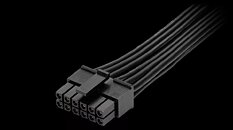- Joined
- Oct 9, 2007
- Messages
- 47,670 (7.43/day)
- Location
- Dublin, Ireland
| System Name | RBMK-1000 |
|---|---|
| Processor | AMD Ryzen 7 5700G |
| Motherboard | Gigabyte B550 AORUS Elite V2 |
| Cooling | DeepCool Gammax L240 V2 |
| Memory | 2x 16GB DDR4-3200 |
| Video Card(s) | Galax RTX 4070 Ti EX |
| Storage | Samsung 990 1TB |
| Display(s) | BenQ 1440p 60 Hz 27-inch |
| Case | Corsair Carbide 100R |
| Audio Device(s) | ASUS SupremeFX S1220A |
| Power Supply | Cooler Master MWE Gold 650W |
| Mouse | ASUS ROG Strix Impact |
| Keyboard | Gamdias Hermes E2 |
| Software | Windows 11 Pro |
NVIDIA is reportedly looking to change the power connector standard for the fourth successive time in a span of three years, with its upcoming GeForce RTX 50-series "Blackwell" GPUs, Moore's Law is Dead reports. NVIDIA began its post 8-pin PCIe journey with the 12-pin Molex MicroFit connector for the GeForce RTX 3080 and RTX 3090 Founders Edition cards. The RTX 3090 Ti would go on to standardize the 12VHPWR connector, which the company would debut across a wider section of its GeForce RTX 40-series "Ada" product stack (all SKUs with TGP of over 200 W). In the face of rising complains of the reliability of 12VHPWR, some partner RTX 40-series cards are beginning to implement the pin-compatible but sturdier 12V-2x6. The implementation of the 16-pin PCIe Gen 6 connector would be the fourth power connector change, if the rumors are true. A different source says that rival AMD has no plans to change from the classic 8-pin PCIe power connectors.
Update 15:48 UTC: Our friends at Hardware Busters have reliable sources in the power supply industry with equal access to the PCIe CEM specification as NVIDIA, and say that the story of NVIDIA adopting a new power connector with "Blackwell" is likely false. NVIDIA is expected to debut the new GPU series toward the end of 2024, and if a new power connector was in the offing, by now the power supply industry would have some clue. It doesn't. Read more about this in the Hardware Busters article in the source link below.
Update Feb 20th: In an earlier version of the article, it was incorrectly reported that the "16-pin connector" is fundamentally different from the current 12V-2x6, with 16 pins dedicated to power delivery. We have since been corrected by Moore's Law is Dead, that it is in fact the same 12V-2x6, but with an updated PCIe 6.0 CEM specification.

View at TechPowerUp Main Site | Source
Update 15:48 UTC: Our friends at Hardware Busters have reliable sources in the power supply industry with equal access to the PCIe CEM specification as NVIDIA, and say that the story of NVIDIA adopting a new power connector with "Blackwell" is likely false. NVIDIA is expected to debut the new GPU series toward the end of 2024, and if a new power connector was in the offing, by now the power supply industry would have some clue. It doesn't. Read more about this in the Hardware Busters article in the source link below.
Update Feb 20th: In an earlier version of the article, it was incorrectly reported that the "16-pin connector" is fundamentally different from the current 12V-2x6, with 16 pins dedicated to power delivery. We have since been corrected by Moore's Law is Dead, that it is in fact the same 12V-2x6, but with an updated PCIe 6.0 CEM specification.

View at TechPowerUp Main Site | Source





